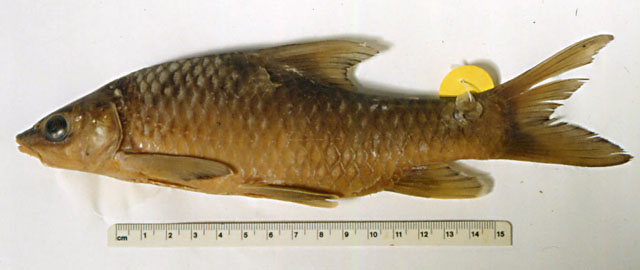| Cyprinidae (Minnows or carps), subfamily: Cyprininae |
| 26.4 cm SL (male/unsexed) |
|
pelagic; depth range 0 - 3 m |
| Africa: Lake Tana. |
|
A small-sized, deep-bodied species, sometimes with a slight nuchal hump (Ref. 35836). A stiff lower jaw, tapering towards a narrow, hypertrophied distal tip, covered with thick skin (Ref. 35836). The protruded mouth does not form a cylindrical tube (Ref. 35836). Long dorsal spine, 19-27% of SL (Ref. 35836). Anal and ventral fins are rather long, 19-24% and 18-21% of SL respectively, with a rather short pectoral-ventral length, 22-26% of SL (Ref. 35836). The caudal peduncle is deep, 11-12% of standard length (Ref. 35836). Scales: 12-14 predorsal scales (Ref. 35836). Live specimens are rather dark greenish brown, the back being darker, with usually greenish fins (Ref. 35836). In alcohol the basic color is a dull yellowish brown, the back being darker (Ref. 35836). |
| Labeobarbus osseensis especially occurs near rocky substrates in water of less than 3 m deep (Ref. 35836). It feeds on adult insects and macrophytes (Ref. 35836). |
|
Vulnerable (B2ab(i,v))
(Ref. 96402)
|
| harmless |
|
Source and more info: www.fishbase.org. For personal, classroom, and other internal use only. Not for publication.
Page created by Jen, 05.08.02,
php script by kbanasihan 06/09/2010 ,
last modified by
dsantos, 20/08/10

